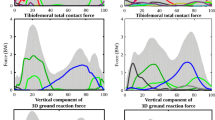Abstract
Measurement of muscle forces related to aging can help to better identify the gait impairment mechanisms in the elderly. To this end, musculoskeletal modeling has been developed to estimate muscle forces. This study aimed to check the validity of OpenSim modeling (i.e., computed muscle control) approach in elderly subjects. Kinematic and kinetic data and Electromyography (EMG) signals for four different muscles were collected in nine healthy elderly males during walking. Dynamic simulation was done within OpenSim. Correlation analysis was performed to quantitatively compare the maximum estimated muscle forces with maximum measured muscle activities during the first double limb support, single limb support, and the second double limb support phases. The area-time plots of OpenSim and EMG data during gait cycle were obtained for qualitative assessment. In quantitative assessment, a low to moderate correlation was observed for the peak of muscle force and muscle activation of four muscles during sub phases of gait. The muscle forces pattern from OpenSim was found to be relatively similar to the muscle activity pattern from EMG especially for Gastrocnemius Medialis. A low to moderate consistency between OpenSim and EMG in the elderly can be explained by using a single mathematical estimation approach.





Similar content being viewed by others
References
Żuk M, Pezowicz C (2015) Kinematic analysis of a six-degrees-of-freedom model based on ISB recommendation: a repeatability analysis and comparison with conventional gait model. Appl Bionics Biomech. https://doi.org/10.1155/2015/503713
Żuk M, Trzeciak M (2016) Anatomical protocol for gait analysis: joint kinematics measurement and its repeatability. J Theor Appl Mech 55:369–376. https://doi.org/10.15632/jtam-pl.55.1.369
Hicks JL, Uchida TK, Seth A, Rajagopal A, Delp SL (2015) Is my model good enough? Best practices for verification and validation of musculoskeletal models and simulations of movement. J Biomech Eng 137:020905. https://doi.org/10.1115/1.4029304
Heller M, Bergmann G, Deuretzbacher G, Dürselen L, Pohl M, Claes L, Haas N, Duda G (2001) Musculo-skeletal loading conditions at the hip during walking and stair climbing. J Biomech 34:883–893. https://doi.org/10.1016/S0021-9290(01)00039-2
Erdemir A, McLean S, Herzog W, van den Bogert AJ (2007) Model-based estimation of muscle forces exerted during movements. Clin Biomech 22:131–154. https://doi.org/10.1016/j.clinbiomech.2006.09.005
Żuk M, Pezowicz C (2016) The influence of uncertainty in body segment mass on calculated joint moments and muscle forces. In: Inf Technol Med Springer, pp. 349–359. https://doi.org/10.1007/978-3-319-39904-1_3.
Čadová M, Gallo L (2013) Is OpenSim suitable for masticatory system analysis. Russian J Biomech 17:53–67. https://doi.org/10.5167/uzh-89161
Heintz S, Gutierrez-Farewik EM (2007) Static optimization of muscle forces during gait in comparison to EMG-to-force processing approach. Gait Posture 26:279–288. https://doi.org/10.1016/j.gaitpost.2006.09.074
Scarton A, Jonkers I, Guiotto A, Spolaor F, Guarneri G, Avogaro A, Cobelli C, Sawacha Z (2017) Comparison of lower limb muscle strength between diabetic neuropathic and healthy subjects using OpenSim. Gait Posture 58:194–200. https://doi.org/10.1016/j.gaitpost.2017.07.117
Żuk M, Syczewska M, Pezowicz C (2018) Use of the surface electromyography for a quantitative trend validation of estimated muscle forces. Biocybern Biomed Eng 38:243–250. https://doi.org/10.1016/j.bbe.2018.02.001
Trinler U, Leboeuf F, Hollands K, Jones R, Baker R (2018) Estimation of muscle activation during different walking speeds with two mathematical approaches compared to surface EMG. Gait Posture. https://doi.org/10.1016/j.gaitpost.2018.06.115
Glitsch U, Baumann W (1997) The three-dimensional determination of internal loads in the lower extremity. J Biomech 30:1123–1131. https://doi.org/10.1016/S0021-9290(97)00089-4
Valente G, Pitto L, Stagni R, Taddei F (2015) Effect of lower-limb joint models on subject-specific musculoskeletal models and simulations of daily motor activities. J Biomech 48:4198–4205. https://doi.org/10.1016/j.jbiomech.2015.09.042
Lin Y-C et al (2012) Comparison of different methods for estimating muscle forces in human movement. Proc Inst Mech Eng H 226:103–112. https://doi.org/10.1177/0954411911429401
Thelen DG, Anderson FC, Delp SL (2003) Generating dynamic simulations of movement using computed muscle control. J Biomech 36:321–328. https://doi.org/10.1016/s0021-9290(02)00432-3
Hermens HJ, Freriks B, Disselhorst-Klug C, Rau G (2000) Development of recommendations for SEMG sensors and sensor placement procedures. J Electromyogr Kinesiol 10:361–374. https://doi.org/10.1016/S1050-6411(00)00027-4
Delp SL et al (2007) OpenSim: open-source software to create and analyze dynamic simulations of movement. IEEE Trans Biomed Eng 54:1940–1950. https://doi.org/10.1109/10.102791
Mukaka MM (2012) A guide to appropriate use of correlation coefficient in medical research. Malawi Med J 24:69–71
Perry J, Davids JR (1992) Gait analysis: normal and pathological function. J Pediatr Orthop 12:815
Benjuya N, Melzer I, Kaplanski J (2004) Aging-induced shifts from a reliance on sensory input to muscle cocontraction during balanced standing. J Gerontol A 59:M166–M171. https://doi.org/10.1093/gerona/59.2.M166
Hallal CZ, Marques NR, Vieira ER, Brunt D, Spinoso DH, Castro A, Cardozo AC, Gonçalves M (2013) Lower limb muscle coactivation levels in healthy younger and older adults during functional dual-task gait. Motriz Rev Educ Fís 19:620–626. https://doi.org/10.1590/S1980-65742013000300013
Dillon CF, Rasch EK, Gu Q, Hirsch R (2006) Prevalence of knee osteoarthritis in the United States: arthritis data from the Third National Health and Nutrition Examination Survey 1991–94. J Rheumatol 33:2271–2279
Ko SU, Ling SM, Schreiber C, Nesbitt M, Ferrucci L (2011) Gait patterns during different walking conditions in older adults with and without knee osteoarthritis—results from the Baltimore longitudinal study of aging. Gait Posture 33:205–210. https://doi.org/10.1016/j.gaitpost.2010.11.006
Acknowledgements
The present study was driven from a dissertation submitted in partial fulfilment of the requirements for the Doctor of Philosophy in Orthotics and Prosthetics by the corresponding author.
Funding
No funding.
Author information
Authors and Affiliations
Corresponding author
Ethics declarations
Conflict of interest
The authors declare that they have no conflict of interest.
Ethical approval
All procedures performed in this study were in accordance with the ethical standards of the University of Social Welfare and Rehabilitation Sciences committee, Ref number: IR.USWR.REC.1396.283) and with the 1964 Helsinki declaration and its later amendments or comparable ethical standards.
Informed consent
Informed consent was obtained from all participants included in the study.
Additional information
Publisher's Note
Springer Nature remains neutral with regard to jurisdictional claims in published maps and institutional affiliations.
Rights and permissions
About this article
Cite this article
Karimi, M.T., Hemmati, F., Mardani, M.A. et al. Determination of the correlation between muscle forces obtained from OpenSim and muscle activities obtained from electromyography in the elderly. Phys Eng Sci Med 44, 243–251 (2021). https://doi.org/10.1007/s13246-021-00973-9
Received:
Revised:
Accepted:
Published:
Issue Date:
DOI: https://doi.org/10.1007/s13246-021-00973-9




